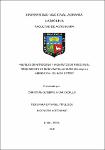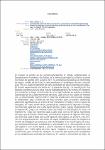Mostrar el registro sencillo del ítem
Niveles de nitrógeno y momentos de riego en el rendimiento de maíz amarillo duro (Zea mays L.) híbrido PM-213, bajo goteo
| dc.contributor.advisor | Hurtado Leo, Lorenzo Miguel | |
| dc.contributor.author | Hijar Cadillo, Christian Guiseppe | |
| dc.date.accessioned | 2018-05-23T14:30:27Z | |
| dc.date.available | 2018-05-23T14:30:27Z | |
| dc.date.issued | 2018 | |
| dc.identifier.other | F04.H55-T BAN UNALM | |
| dc.identifier.uri | https://hdl.handle.net/20.500.12996/3302 | |
| dc.description | Universidad Nacional Agraria La Molina. Facultad de Agronomía. Departamento Académico de Suelos | es_PE |
| dc.description.abstract | El ensayo se realizó en la Unidad experimental en Riego, perteneciente al Departamento Académico de Suelos de la Universidad Agraria La Molina durante los meses de agosto 2015 a enero 2016. Se estudió la respuesta a los momentos de riego y niveles de fertilización nitrogenada en el rendimiento de maíz amarillo duro PM-213, bajo condiciones de riego localizado de alta frecuencia por goteo. El diseño experimental empleado en el presente trabajo de investigación fue bloques completos al azar para realizar la prueba de los tres niveles de nitrógeno por momento de riego. Posteriormente en arreglo factorial se realizó el análisis combinado de los cuatro momentos de riego, cada uno de los cuales se manejó con un determinado régimen hídrico. Bajo las condiciones del presente ensayo el rendimiento total y comercial de maíz amarillo duro, presentan diferencias altamente significativas por efecto de los momentos de riego y de los niveles de nitrógeno. El mayor rendimiento comercial se presenta en el régimen R1 (riego con intervalo cada día) con 9,058 kg/ha de maíz grano, similar estadísticamente al régimen R2 (riego con intervalo cada dos días) con 8.821 kg/ha de maíz y al régimen R3 (riego con intervalo cada cuatro días) con 8,949 kg/ha, regímenes de riego que presentan diferencias porcentuales respecto al régimen R4 (riego con intervalo cada 8 días) con 6,296 kg/ha de maíz grano, de 143.8%, 140.1% y 142.1% respectivamente. Asimismo, el mayor rendimiento comercial respecto a niveles de nitrógeno caracteriza al nivel de 90 kg/ha N con 9,249 kg/ha de maíz, que presenta diferencias estadísticas y porcentuales de 13.6% respecto al nivel 180 kg/ha N con 8,249 kg/ha y 25.9% respecto al testigo no fertilizado con nitrógeno con 7,345 kg/ha de maíz gano Respecto a los componentes del rendimiento, para niveles de nitrógeno se encontró alta significación estadística en la variable peso promedio de mazorca. En cuanto a momentos de riego, se encontró alta significación estadística en la variable número de mazorcas/planta y significativa en la variable número de plantas/m2. En general, durante los 162 días de periodo vegetativo del cultivo de maíz amarillo duro, los registros de la humedad del suelo indican que para los momentos de riego con intervalos de cada día (R1), cada dos días (R2), cada cuatro días (R3) y cada ocho días (R4) fueron; 21.09%, 19.91%, 19.52 y 16.78 % humedad en volumen, siendo la succión mátrica media de 0.43 bar, 0.60 bar, 0.66 bar y 1.35 bar respectivamente. Bajo las condiciones del ensayo, los parámetros agronómicos que caracterizan al cultivo de maíz amarillo duro indican para el intervalo de riego cada día (R1), una eficiencia de uso de agua (EUA) de 2.1 kg/m3, un índice de cosecha (IC) de 53%, el índice de área foliar (IAF) de 4.52 m2/m2 y el coeficiente de transpiración (CT) de 264.5 l/kg. Para el intervalo de riego cada dos días (R2), una EUA de 2.0 kg/m3, un IC de 60.1%, un IAF de 4.59 m2/m2 y un CT de 257.61 l/kg. Para el intervalo de riego cada cuatro días (R4), una EUA de 2.1 kg/m3 y un IC de 60.9%, una IAF de 4.54 m2/m2y un CT de 266.32 l/kg y para el intervalo de riego cada ocho días (R4), una disminuida EUA de 1.45 kg/m3 y un IC de 58.9%, una IAF de 4.71 m2/m2 y un CT de 279.10 l/kg. Los resultados del análisis agro-económico para las cuatro frecuencias de riego indican que el mayor índice de rentabilidad caracteriza al intervalo de riego diario y para niveles de nitrógeno el valor más alto lo caracteriza el nivel 90 kg/ha de N con un IR de 65%. Asimismo, el intervalo de riego cada cuatro días con el nivel 90 kg/ha N, muestran el mayor IR de 82.8% y el menor valor, se presenta en el intervalo de riego cada ocho días a nivel del testigo no fertilizado con nitrógeno, con un IR de -2.9%. | es_PE |
| dc.description.abstract | The experiment was carried out at the Experimental Irrigation Unit, belonging to the Soils Academic Department of “La Molina” National Agrarian University from August 2015 to January 2016. The subject of study was the response to the moments of irrigation and nitrogen levels of fertilization in the “maíz amarillo duro” PM-213, under high frequency localized drip irrigation conditions. The experimental design used in this investigation was the randomized block design in order to have three nitrogen levels per irrigation timing. After this, in the factorial adjustment the combined analysis of the four moments of irrigation was done, each one of them was set up with a specific water regimen. Under the conditions of the current experiment the total and commercial yield of the “maiz amarillo duro” present highly significant differences because of the moments of irrigation effects and the nitrogen levels. The commercial greatest yield is shown in the R1 regimen (irrigation with daily intervals) with 9.058 kg/ha of corn grain, statistically similar to the R2 regimen (irrigation with two days intervals) with 8.821 kg/ha of corn, and to the R3 regimen (irrigation with four days intervals) with 8,949 kg/ha. These irrigation regimens have percental differences compared to the R4 regimen (irrigation with eight days intervals) with 6,296 kg/ha of corn grain; presenting 143.8%, 140.1% and 142.1% respectively. Likewise, the greatest commercial yield regarding nitrogen levels classify the 90 kg/ha N level with 9,249 kg/ha of corn, presenting statistical and percental differences of 13.6 % compared to the 180 kg/ha N level with 8,249 kg/ha and 25,9% in contrast to the free of nitrogen control sample with 7,345 kg/ha of corn grain. Regarding the yield components, for the nitrogen levels high statistical significance was found in the average weight of the cob variable. Respecting the moments of irrigation, was found high statistical significance in the number of cobs/plant variable and also in the number of plants/m2 variable. In general, during the 162 days of vegetative period of the crop “maiz Amarillo duro”, the values for the soil humidity indicate that for the moments of irrigation with one day interval (R1), two days interval (R2), four days interval (R3) and eight days interval (R4) were; 21.09%, 19.91%, 19.52% and 16.78% of humidity in volume respectively, being the average mace suction of 0.43 bar, 0.60 bar, 0.66 bar and 1.35 bar respectively. Under the experiment conditions, the agronomic parameters that characterize the “maiz amarillo duro” crop indicate that for the R1 regimen the efficiency of water-use (WUE) is 2.1 kg/m3, harvest index (HI) of 53%, leaf area index (LAI) of 4.52 m2/m2 and the transpiration coefficient (TC) of 264.5 l/kg, For the irrigation regimen R2, a WUE of 2.0 kg/m3 , a HI of 60.1%, a LAI of 4.59 m2/m2 and a TC of 257.61 l/kg. For the R3 regimen a WUE of 2.1 kg/m3, a HI of 60.9%, a LAI of 4.54 m2/m2 and a TC of 266.32 l/kg. The irrigation interval R4 a decreased WUE of 1.45 kg/m3, a HI of 58.9%, a LAI of 4.71 m2/m2 and TC of 279.10 l/kg. The results of the agronomic-economic analysis for the different irrigation moments, indicate that the greatest index of profit is the daily irrigation interval and the highest value in nitrogen levels is the 90 kg/ha of N with a IR of 65%. Also, the irrigation interval of four days with the 90 kg/ha level, shows the highest IR of 82.8 % and the lowest value is presented in the irrigation interval of eight days in the control sample with an IR of -2.9%. | en_US |
| dc.format | application/pdf | en_US |
| dc.language.iso | spa | es_PE |
| dc.publisher | Universidad Nacional Agraria La Molina | es_PE |
| dc.rights | info:eu-repo/semantics/openAccess | en_US |
| dc.rights.uri | https://creativecommons.org/licenses/by-nc-nd/4.0/ | * |
| dc.subject | Zea mays | es_PE |
| dc.subject | Híbridos | es_PE |
| dc.subject | Nitrógeno | es_PE |
| dc.subject | Efectos de dosificación | es_PE |
| dc.subject | Rendimiento de cultivos | es_PE |
| dc.subject | Riego | es_PE |
| dc.subject | Respuesta de la planta | es_PE |
| dc.subject | Características agronómicas | es_PE |
| dc.subject | Riego por goteo | es_PE |
| dc.subject | Evaluación | es_PE |
| dc.subject | Perú | es_PE |
| dc.subject | Maíz amarillo duro híbrido PM-213 | es_PE |
| dc.subject | Parámetros agronómicos | es_PE |
| dc.title | Niveles de nitrógeno y momentos de riego en el rendimiento de maíz amarillo duro (Zea mays L.) híbrido PM-213, bajo goteo | es_PE |
| dc.type | info:eu-repo/semantics/bachelorThesis | en_US |
| thesis.degree.discipline | Agronomía | es_PE |
| thesis.degree.grantor | Universidad Nacional Agraria La Molina. Facultad de Agronomía | es_PE |
| thesis.degree.name | Ingeniero Agrónomo | es_PE |
| dc.subject.ocde | http://purl.org/pe-repo/ocde/ford#4.01.04 | es_PE |
| renati.author.dni | 46038173 | es_PE |
| dc.publisher.country | PE | es_PE |
| dc.type.version | info:eu-repo/semantics/publishedVersion | en_US |
| renati.advisor.orcid | https://orcid.org/0000-0002-5202-3971 | es_PE |
| renati.advisor.dni | 07922950 | es_PE |
| renati.type | https://purl.org/pe-repo/renati/type#tesis | es_PE |
| renati.level | https://purl.org/pe-repo/renati/level#tituloProfesional | es_PE |
| renati.discipline | 811036 | es_PE |
| renati.juror | Loli Figueroa, Oscar Oswaldo | |
| renati.juror | Rodríguez Soto, Gilberto | |
| renati.juror | Beingolea Peña, Luis |
Ficheros en el ítem
Este ítem aparece en la(s) siguiente(s) colección(ones)
-
AGR-SU Tesis [119]




